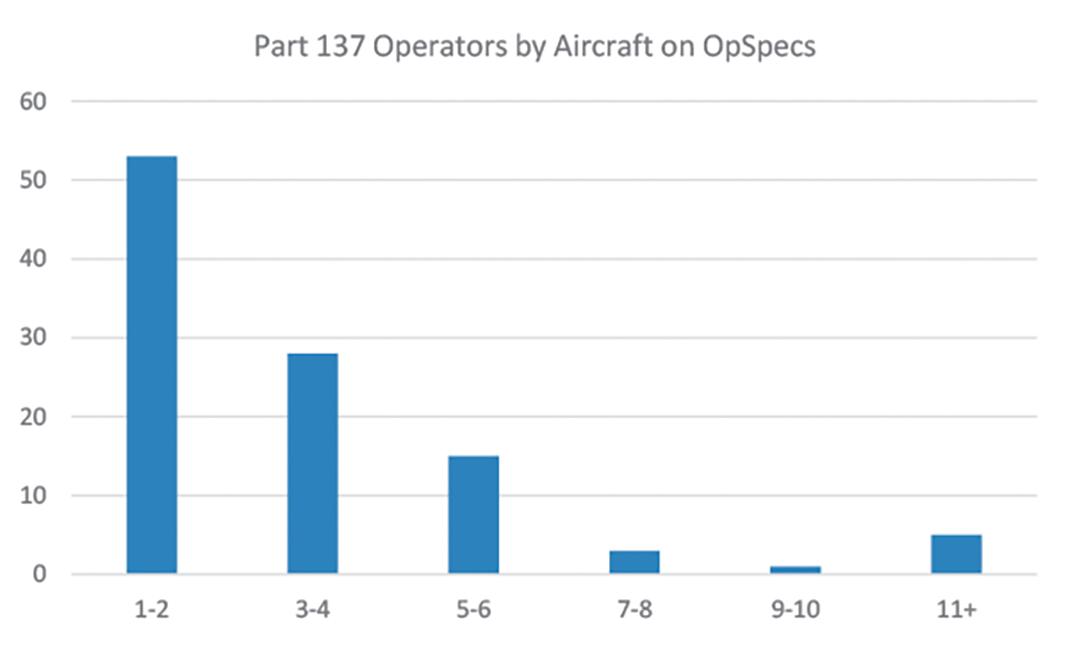
4 minute read
New Zealand Agricultural Aviation Update, November 2019 through May 2020
There are currently 105 active Part 137 operators in New Zealand. There are 376 aircraft on Part 137 OpSpecs with 276 helicopters and 100 aeroplanes.
There were 243,183 total tonnes reported applied for Quarter 1 of 2020; 1,705 more than Quarter 1 of 2019. Helicopters reported 7,227 fewer liquid tonnes and 13,437 more solid tonnes than Quarter 1 2019. Aeroplanes reported 4,504 fewer tonnes applied.
There were six accidents on agricultural operations in 2019 and there have been three in 2020 to date, one was fatal. The following accidents are summarized:
In January at Hawke’s Bay, an AS 350 had loss of control/performance management. The aircraft was engaged in wilding pine spray operations. As a result of the helicopter’s low speed and the variable wind conditions at the time, tail rotor control was lost and the machine crashed, ending up on its side in a clearing with substantial damage.
In April near Wairarapa a Cresco was involved in a takeoff accident. On the third load of the morning, the aircraft failed to achieve takeoff before the end of the airstrip. The aircraft dropped over the end of the airstrip, banked to the right and whilst vertical hit a tree with its right wing and then impacted the ground shortly afterwards, fatally injuring the pilot.
In May near Nelson/Marlborough a Hughes 500 was involved in a main rotor blade strike with terrain. During a wilding pine clearing operation, the main rotor blades came into contact with terrain. Following the main rotor strike, the pilot was able to safely land the helicopter.
Other Occurrences February Otago Cresco Ground Crew
Numerous other occurrences were reported between
November 2019 and May 2020. These included:
• Cresco’s flaps damaged by a loader truck.
• An R44 made a precautionary landing from door not closed properly.
• Ground crew ran over the pilot door of a AS 350.
• While on a boundary spray run the right hand tip of the spray boom came in contact with a willow tree.
• A Fletcher reported restricted movement of its elevator during topdressing operations. The aft-most elevator cable pulley found to be jamming intermittently due to fertilizer hardened in the pulley recess.
• An AS 350’s cargo hook found to have its load beam pivot shaft had migrated through the load beam and became disengaged from the support bearing.
• During fire bucket operations the sectional steel ring at the top of the fire bucket dislodged causing the bucket to behave erratically on an AS 350.
• During takeoff, the electric trim motored to almost full up without pilot activation on a Cresco. Pilot saved the aircraft by pulling the trim motor circuit breaker.
• A Bell 206 sank into the crop shortly after takeoff with the starboard boom contacting the crop and ground, breaking off.
• On an R66, the fuel cut off and throttle were found to be rigged incorrectly resulting in the control cables having next to no protrusion through the control bolts.
• After takeoff, the pilot of a Cresco was unable to move the hopper lever to release a load of fertilizer. It was found two hopper lever bolts loose and one missing.
• Pilot reported upon a fertilizer bucket inspection with the AS 350 at idle, looked up to see the rotor disc had tilted back due to insufficient cyclic friction. Main rotor droop stops found bent, one cracked from impact.
• A Hughes 500 landed with oil splatters over cowl doors. The pilot found two engine nozzles not lockwired and completely closed, allowing oil to leak.
• Wire strikes continue to plague New Zealand pilots with three in November and December 2019. In Rotorua, an R44 was spraying steep paddocks with distribution lines running through them. While doing a boundary run and spraying uphill, the pilot was avoiding spraying some trees that were obscuring the power pole. The pilot reported that once the wires became visible it was too late. He saw them clear the helicopter bubble, then the wires hit the mast of the helicopter. The wires separated from the nearby joiners and sprung free.
• In Nelson/Marlborough, a Bell 206 encountered a wire strike while conducting spray operations. On the fourth load of the morning while spot spraying broom the pilot spotted two plants close to the wires. A short high recon flight was carried out to determine whether there was enough room to get alongside the wires or whether it would be necessary to spray from above the wires. The pilot determined there was enough room to get lower alongside one wire to spray the plants. Once the plants had been sprayed another plant was spotted downslope on the other side of the wire. After spraying the plant, the pilot turned away from the wire and started to descend downslope striking another wire. The wire struck the front stays of the spray booms and the chin of the helicopter, missing the lower wire cutter and the toes of the skids. The helicopter backed off the wire and landed. There was minor damage to the aircraft.
• The third wire strike occurred during the first spray load of the day, at the end of a spray run when the ground wire on a set of power lines came into contact with the helicopter skid. Flaring the helicopter to a hover as the wire broke at the power pole, the pilot was able to back away from the wire and land back at the load site. A few scratches were found on the skid fairings; all else was fine.






